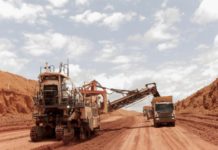
[miningmx.com] –SOUTH Africa’s largest iron ore exporter – Kumba Iron Ore (Kumba) – would like to get directly involved in the operation of Sishen-Saldanha line, according to its CEO Chris Griffith.
Interviewed during a site visit to Kumba’s Sishen South mine (now renamed the Kolomela mine) which is under construction, Griffith acknowledged the issue was a sensitive one. He said: “We do a lot of tap-dancing around it.’
This is because although Transnet Freight Rail (TFR) maintains it is running Sishen-Saldanha to international best practice, Griffith believes it could be better operated with private sector involvement.
Two of Kumba’s competitors – Rio Tinto and BHP Billiton – maintain they have a competitive advantage in the iron ore export business because they own and operate their own railway lines and port handling infrastructure in Western Australia.
Griffith agreed with that assessment.
Transnet acting CEO Chris Wells has strongly defended TFR’s running of the Sishen-Saldanha line.
He told Miningmx he was aware of the criticism, but said: “On any measure you care to apply, we are running the Sishen-Saldanha line as a world class operation.’
The eventual outcome of this debate could have major implications for the proposed increase of export capacity on the line beyond the current planned expansion to 60 million tonnes (mt) per year.
Griffith said: “Transnet has not done a bad job, but we believe the line can be run better. If there was an opportunity to run those assets in collaboration with government, we would jump at it.
“But there are some things you can change and others you can’t. You have to just get on and make the best of the environment in which you find yourself.’
Transnet has just completed the Phase 1A expansion of capacity on the line to 41mt/year, and is about to start the Phase 1B expansion to 47mt/year. The parastatal said in its 2009 financial results that approval “in principle’ had been obtained to go ahead with the R4.3bn Phase 1C expansion to 60mt/year.
The country’s two major iron ore exporters, Kumba and Assmang, previously indicated their desire to push exports well above the 60mt/year level and had been talking about going to 95mt/year.
The first indication this may not happen was given on October 29, when Wells told Miningmx: “There has been a rethink on the economics of further expansion to the 95mt/year capacity.
“After assessing the capital cost of getting to 95mt/year, it’s clear that a prohibitive tariff would have to be charged. The result is that iron ore exporters are still keen to expand their capacity above 60mt/year, but not to 95mt/year.’
That’s not quite the way the iron ore exporters see the situation.
A source said: “On the Transnet figures, there is not going to be any expansion of the Sishen-Saldanha line above 60mt/year. The cost and the tariff are just too high.
“We have to take a radically different approach to find a solution. We need to get in new people with fresh views to assess the situation. Maybe we need to get the work done by Chinese contractors if that will drastically reduce the estimated cost.’
A major change already being looked at for any growth beyond 60mt/year is to diversify the line to handle about 12mt/year of manganese exports as well as iron ore.
South Africa’s manganese deposits are located in the same region of the Northern Cape as the iron ore deposits.
Wells said Transnet was looking at a proposal to push capacity on the line to just under 90mt/year, of which 75mt would be allocated to the iron ore exporters and 12mt to the manganese mines.
The balance of about 2mt/year is being kept in reserve for small black economic empowerment (BEE) iron ore producers, of which there are as yet none.
Griffith welcomed the decision to include the manganese exporters on the line, with one proviso which concerned the design of the expanded port facilities to handle the two commodities.
He said: “We believe the mining industry has a role to play in the expansion above 60mt/year. Our key concern as iron ore exporters is to ensure that there is no contamination of the iron ore stockpiles at Saldanha Bay from the manganese stockpiles.
“That is a huge issue for us, and the expanded port has to be designed to make sure that this does not happen. “
Griffith added Transnet and the iron ore exporters had a window of about three years to carry out the necessary studies assessing the future of the Sishen-Saldanha line above 60mt/year.










